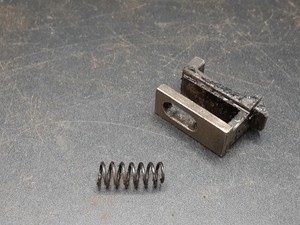

The stock wood is scraped along sides of the stock where it comes up under the front of the barrel and is affixed with what looks like a machine screw. One of my last Type 99 Arisaka purchases has a monopod. I guess once I received the rifle, I'll unfold the monopod and take picture of the stock. I was informed that monopod is a repro since, from the picture, stock is lack of marring or indentation from the monopod itself. It's possible it was doctored but if I did a job like that I would have made it look much better, why so rough? Also, notice how the "Type 99" markings are also rough like the mum. There is a possibility that it was welded and then restamped, but it seems like a huge job for minimal return. Also, the dust cover groove is intact, sharp, and no dishing The chisel lines that line up the barrel are intact. If the receiver had been ground, the entire ground area would be dished out, and I'm not seeing that. I am a metal fabricator and I'd have to say it's just a poorly finished receiver. Remember there is no shellac ever used on any Japanese rifles. The proof would be in the car touches if we could see the area behind the trigger guard on the stock. Look at the gouges in the stock, they look deep and un-messed with. Nagoya almost always used walnut and had a brownish urushi, I am sitting in front of one right now. I think the stock looks refinished.Color looks like too much "walnut" color.not enough gold and doesn't look like theres any shellac. I'll throw in a dissenting opinion on this one. The machining on the receiver is typically beautiful, like this: I have an early 1940 Kokura with the works (including a matching dust cover) and it is probably good for at least $800 these days. If the stock matches, has the original Urushi, and the screws are still staked (and all the major part numbers match) it's easily a $600-1000 gun. If it was ground and then "touched up" by some con-artist I would expect it to be quite a bit more obvious, and something tells me it is original. 1943 was a transitional year where things started to get worse, but given the bipod and aircraft sights it does not seem to be late enough to have been poorly effected. The roughness on top of the receiver is puzzling.

How do the screws holding in the action look? Are they still staked? Easily missed as gouges or marks on the stock, so look closely. They can be one thing to tell you if the stock is original to the rifle.
1939 TYPE 99 ARISAKA MARKINGS SERIES
In the back of the trigger guard on the stock there should be a series of marks, sometimes hard to see if they are worn or have been finished over. Does it have an iridescent quality to it when you shine light on it? Nagoya had that brown Urushi, the finish looks original to me in the pics but it is sometimes hard to tell.


 0 kommentar(er)
0 kommentar(er)
